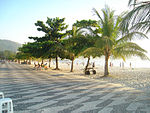Estádio Caio Martins

Estádio Caio Martins, sometimes called Estádio Mestre Ziza, is a football stadium in Niterói, Rio de Janeiro state, Brazil. The stadium holds 12,000 people. It was built in 1941. The stadium is owned by the Rio de Janeiro state government. The stadium's name honors Caio Vianna Martins. In 1938 15-year-old Scout Martins, along with many other passengers, was seriously injured in a train accident, but refused the offer of a stretcher, saying that others needed it more than he. Martins walked to the aid location but died soon after. Nowadays, the stadium is also home for the 15th Scout Group Martim Afonso (Portuguese:15º Grupo Escoteiro Martim Afonso), one of the oldest groups in Niterói, with more than 55 years. The nickname Mestre Ziza, meaning Master Ziza, honors the late Zizinho, a Brazilian footballer who played the 1950 FIFA World Cup.
Excerpt from the Wikipedia article Estádio Caio Martins (License: CC BY-SA 3.0, Authors, Images).Estádio Caio Martins
Avenida Roberto Silveira, Niterói Icaraí (Região Praias da Baía)
Geographical coordinates (GPS) Address External links Nearby Places Show on map
Geographical coordinates (GPS)
| Latitude | Longitude |
|---|---|
| N -22.900555555556 ° | E -43.105833333333 ° |
Address
Complexo Esportivo Caio Martins
Avenida Roberto Silveira
24230-151 Niterói, Icaraí (Região Praias da Baía)
Rio de Janeiro, Brazil
Open on Google Maps






